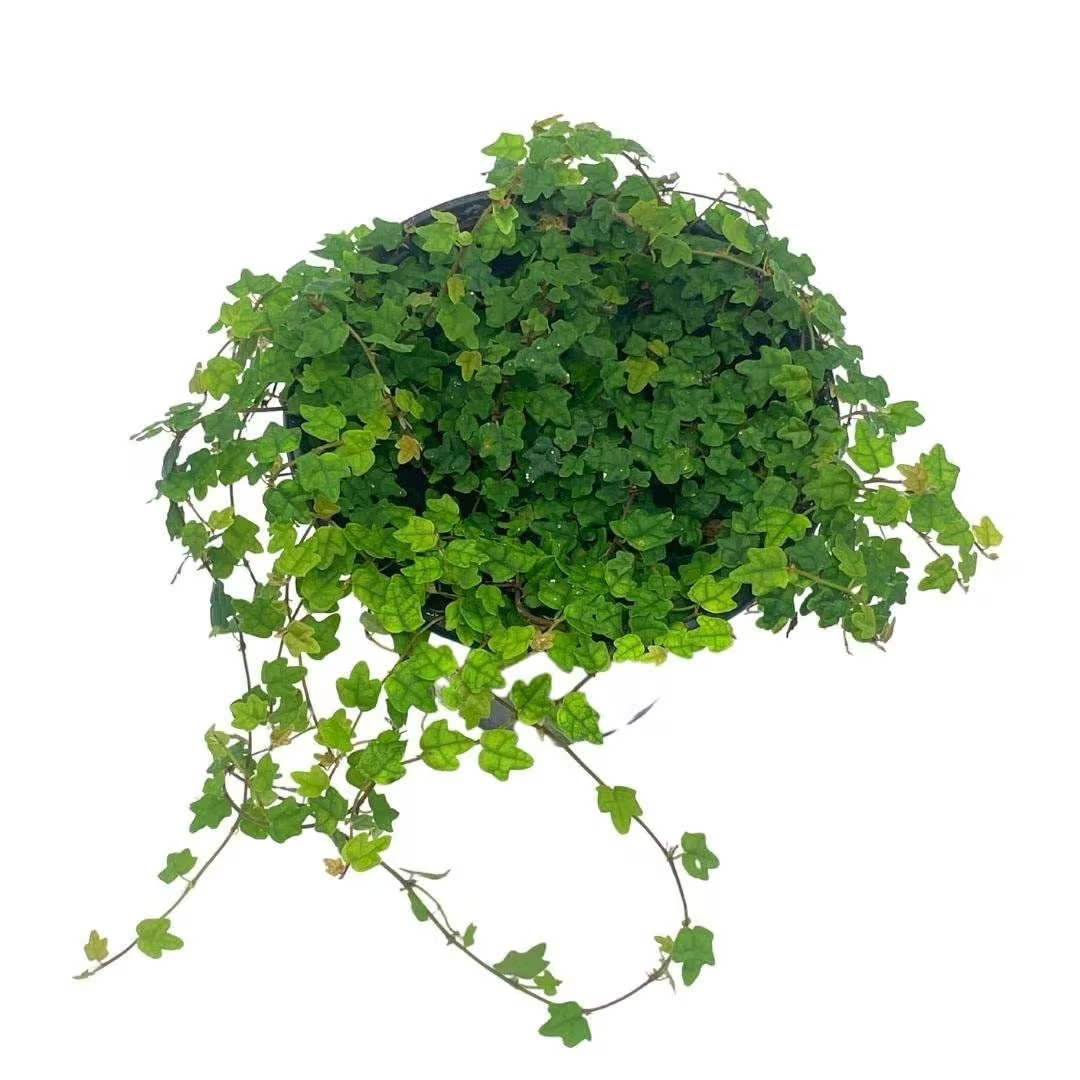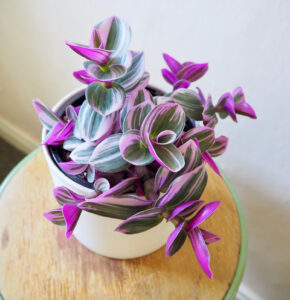The String of Frogs (Curio radicans), sometimes referred to as Trailing Jade or String of Frogs (due to the unique frog-like shape of its leaves), is a captivating trailing succulent that is a lesser-known member of the Senecio family, closely related to the popular String of Pearls and String of Bananas. It has become increasingly popular due to its striking, textured leaves and cascading growth habit, making it an ideal choice for hanging baskets, shelves, and other decorative plant displays.
Here’s a detailed care guide for String of Frogs:
1. Overview and Characteristics
- Scientific Name: Curio radicans (previously Senecio radicans)
- Common Name: String of Frogs, Trailing Jade, or Frog’s Foot
- Family: Asteraceae (the daisy family)
- Native to: South Africa
- Growth Habit: Trailing, spreading vines that can grow up to 3 feet long in ideal conditions.
- Leaf Shape: The leaves resemble small, rounded, frog’s feet with a smooth, thick texture. They are usually green, but they can sometimes take on a bluish or reddish tint, particularly when exposed to bright light.
Its unique leaves, shaped like little frog feet, give it an intriguing appearance, making it a conversation starter in any collection. The plant is also relatively easy to care for, making it perfect for both beginner and experienced succulent gardeners.
2. Light Requirements
Like most succulents, the String of Frogs thrives in bright light but can tolerate a bit of direct sunlight. However, just like its cousins in the Senecio family, too much direct sun can cause the leaves to scorch or burn.
Ideal Light Conditions:
- Indoors: Place your String of Frogs near a bright, south- or west-facing window where it will receive indirect sunlight. It can tolerate some direct sunlight but avoid prolonged exposure, especially during the hottest parts of the day.
- Outdoors: If grown outdoors, make sure it’s in a location that gets partial sun or dappled shade, as full sun can scorch the delicate leaves.
If it doesn’t get enough light, the plant will become leggy, and the growth will be sparse and stretched out.
3. Watering Needs
String of Frogs is a drought-tolerant plant that prefers to be on the dry side, so it’s very important to avoid overwatering. Overwatering is one of the most common causes of succulent death, as it can lead to root rot.
Watering Tips:
- Let the soil dry out completely before watering. You can check by sticking your finger into the soil—if it feels dry about 2 inches down, it’s time to water.
- Water thoroughly but allow the excess water to drain from the pot to prevent water from accumulating around the roots.
- During the growing season (spring and summer), water every 7–10 days depending on your climate, while in the dormant season (fall and winter), reduce watering to once every 3–4 weeks.
Tip: It’s better to underwater than to overwater. If you’re unsure, wait a few extra days before watering again.
4. Soil Preferences
String of Frogs requires well-draining soil that allows water to pass through quickly, as succulents do not tolerate sitting in wet soil.
Ideal Soil Mix:
- A succulent or cactus mix is perfect.
- You can make your own mix by combining:
- 1 part potting soil
- 1 part perlite or sand for drainage
- 1 part coco coir or pine bark to maintain moisture balance without retaining too much water.
If the soil doesn’t drain well, the roots may become waterlogged and rot.
5. Temperature and Humidity
The String of Frogs is a tropical plant native to South Africa, so it thrives in moderate temperatures and low humidity.
Temperature:
- It prefers warm temperatures ranging from 65°F to 85°F (18°C to 29°C).
- Minimum temperature: It can tolerate temperatures as low as 50°F (10°C) but should never be exposed to frost or freezing temperatures.
Humidity:
- As a succulent, String of Frogs prefers low humidity levels. It can handle the average humidity in most homes but does not do well in constantly humid environments.
If growing outdoors, make sure to bring it inside if temperatures dip below 50°F (10°C), as this can cause damage to the plant.
6. Fertilizing
String of Frogs does not require heavy feeding, but light fertilizing during the growing season can help boost its growth and overall health.
Fertilizing Tips:
- During the growing season (spring and summer), fertilize once every 4–6 weeks using a diluted balanced liquid fertilizer (such as 10-10-10) or a cactus/succulent-specific fertilizer.
- During the dormant months (fall and winter), stop fertilizing, as the plant’s growth slows down, and it doesn’t require as many nutrients.
Be sure to dilute the fertilizer to avoid overfeeding, which can lead to leggy growth.
7. Pruning and Maintenance
Pruning String of Frogs isn’t strictly necessary, but it can help keep the plant healthy and promote fuller growth. This also allows you to manage its size and shape.
Pruning Tips:
- If the plant becomes too leggy or long, simply cut back the vines to a length that you find visually pleasing. Use sharp, clean scissors to ensure a clean cut.
- Remove dead or damaged leaves as needed to maintain the plant’s overall appearance.
- After pruning, the cuttings can be propagated to create new plants.
8. Propagation
Propagation of String of Frogs is relatively easy and is usually done via stem cuttings. It’s a great way to multiply your plant or share with friends.
Steps for Propagation:
- Take a cutting: Using clean scissors or pruning shears, cut a healthy vine with at least a couple of leaves.
- Let the cutting dry: Allow the cut end of the stem to dry for 1–2 days. This allows the cutting to callus over, reducing the risk of rot.
- Plant the cutting: After the cutting has dried, plant it in a small pot filled with a well-draining succulent soil mix.
- Water sparingly: Water the cutting lightly after planting, but let the soil dry out between waterings to avoid root rot.
- Wait for roots: After a few weeks, the cutting should begin to root. You can check by gently tugging on the plant to feel resistance, indicating that the roots have established.
Once rooted, the cutting can be moved to a larger pot or transplanted into your garden.
9. Pests and Problems
String of Frogs is fairly pest-resistant, but like all succulents, it may occasionally attract some common pests.
Common Pests:
- Mealybugs: These pests look like small cotton balls and can cause damage to the plant. They can be removed with rubbing alcohol or insecticidal soap.
- Aphids: Small insects that often gather on the undersides of leaves. Aphids can be removed by spraying the plant with water or applying insecticidal soap.
- Spider Mites: These tiny pests can cause the leaves to become speckled and discolored. Increase humidity slightly and treat with insecticidal soap or neem oil.
Common Problems:
- Overwatering: The most common issue with succulents, leading to root rot. Always let the soil dry out before watering.
- Leggy Growth: If the plant becomes too leggy, it is usually a sign that it’s not getting enough light. Move it to a brighter location.
- Yellowing or Dropping Leaves: This can be a sign of overwatering, underwatering, or poor drainage. Adjust watering habits and check the soil for good drainage.
10. Container and Hanging Basket Care
The String of Frogs thrives in containers that provide ample drainage. Hanging baskets or decorative pots work particularly well since it has a trailing growth habit.
Container Tips:
- Choose a container with drainage holes to ensure that excess water can escape.
- Terracotta or ceramic pots work well, as they are porous and allow moisture to evaporate more efficiently than plastic pots.
- Hang your plant in a location that receives bright, indirect sunlight for the best growth.
Conclusion
The String of Frogs is an elegant and low-maintenance succulent that makes a great addition to any plant collection. With its unique, frog-foot-shaped leaves and trailing growth, it’s sure to be a showstopper in any space. By providing the right light, watering, and soil conditions, you can enjoy this beautiful plant for many years.


